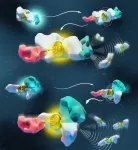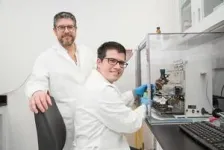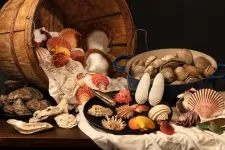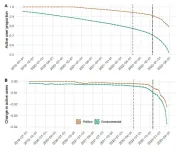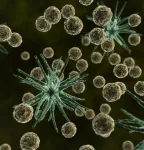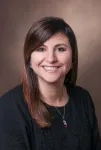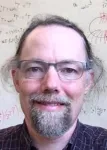(Press-News.org) Two molecular languages at the origin of life have been successfully recreated and mathematically validated, thanks to pioneering work by Canadian scientists at Université de Montréal.
Published this week in the Journal of American Chemical Society, the breakthrough opens new doors for the development of nanotechnologies with applications ranging from biosensing, drug delivery and molecular imaging.
Living organisms are made up of billions of nanomachines and nanostructures that communicate to create higher-order entities able to do many essential things, such as moving, thinking, surviving and reproducing.
“The key to life’s emergence relies on the development of molecular languages – also called signalling mechanisms – which ensure that all molecules in living organisms are working together to achieve specific tasks," said the study's principal investigator, UdeM bioengineering professor Alexis Vallée-Bélisle.
In yeasts, for example, upon detecting and binding a mating pheromone, billions of molecules will communicate and coordinate their activities to initiate union, said Vallée-Bélisle, holder of a Canada Research Chair in Bioengineering and Bionanotechnology.
“As we enter the era of nanotechnology, many scientists believe that the key to designing and programming more complex and useful artificial nanosystems relies on our ability to understand and better employ molecular languages developed by living organisms,” he said.
Two types of languages
One well-known molecular language is allostery. The mechanism of this language is "lock-and-key": a molecule binds and modifies the structure of another molecule, directing it to trigger or inhibit an activity.
Another, lesser-known molecular language is multivalency, also known as the chelate effect. It works like a puzzle: as one molecule binds to another, it facilitates (or not) the binding of a third molecule by simply increasing its binding interface.
Although these two languages are observed in all molecular systems of all living organisms, it is only recently that scientists have started to understand their rules and principles – and so use these languages to design and program novel artificial nanotechnologies.
“Given the complexity of natural nanosystems, before now nobody was able to compare the basic rules, advantage or limitations of these two languages on the same system,” said Vallée-Bélisle.
To do so, his doctoral student Dominic Lauzon, first author of the study, had the idea of creating a DNA-based molecular system that could function using both languages. “DNA is like Lego bricks for nanoengineers,” said Lauzon. “It's a remarkable molecule that offers simple, programmable and easy-to-use chemistry.”
Simple mathematical equations to detect antibodies
The researchers found that simple mathematical equations could well describe both languages, which unravelled the parameters and design rules to program the communication between molecules within a nanosystem.
For example, while the multivalent language enabled control of both the sensitivity and cooperativity of the activation or deactivation of the molecules, the corresponding allosteric translation only enabled control of the sensitivity of the response.
With this new understanding at hand, the researchers used the language of multivalency to design and engineer a programmable antibody sensor that allows the detection of antibodies over different ranges of concentration.
“As shown with the recent pandemic, our ability to precisely monitor the concentration of antibodies in the general population is a powerful tool to determine the people's individual and collective immunity,” said Vallée-Bélisle.
In addition to expanding the synthetic toolbox to create the next generation of nanotechnology, the scientist’s discovery also shines a light on why some natural nanosystems may have selected one language over another to communicate chemical information.
About this study
The article “Programming chemical communication: allostery vs multivalent mechanism," by Dominic Lauzon and Alexis Vallée-Bélisle, was published August 15, 2023 in the Journal of the American Chemical Society.
Funding was provided by the National Sciences and Engineering Research Council of Canada, the Canada Research Chairs program, and Les Fonds de recherche du Québec – Nature et technologies.
END
Decoding how molecules "talk" to each other to develop new nanotechnologies
2023-08-15
ELSE PRESS RELEASES FROM THIS DATE:
Favored asylum seekers are young, female and fleeing war
2023-08-15
Russia’s attack on Ukraine has resulted in one of the largest movements of refugees since the Second World War. More than 7.4 million Ukrainians have sought asylum in Europe, almost three times the number of people who found refuge in Europe during Syria’s civil war in 2015 and 2016.
To investigate whether and how the willingness of host populations to receive refugees has changed since 2016, an international research team involving ETH Zurich, the University of California, Berkeley, and Stanford University surveyed 33,000 people in 15 European countries. The first wave of the survey took place in February 2016 and the second from May to June ...
More than 800 human-harvested shellfish species tend to be more resistant to extinction
2023-08-15
In a new study, scientists Stewart Edie of the Smithsonian, Shan Huang of the University of Birmingham and colleagues drastically expanded the list of bivalve species, such as clams, oysters, mussels, scallops and their relatives, that humans are known to harvest and identified the traits that make these species prime targets for harvesting. They also discovered that some of these same traits have also made this group of shellfish less prone to extinction in the past and may protect these shellfish in the future. The authors flagged certain ocean regions, such as the east Atlantic and northeast and southeast Pacific, as areas of special concern for management and conservation.
The ...
Nearly 50% of environmentalists abandoned Twitter following Musk’s takeover
2023-08-15
In October 2022, Elon Musk purchased Twitter (recently renamed X), which had previously served as the leading social media platform for environmental discourse. Since then, reports a team of researchers in the journal Trends in Ecology and Evolution on August 15, there has been a mass exodus of environmental users on the platform—a phenomenon that could have serious implications for public communication surrounding topics like biodiversity, climate change, and natural disaster recovery.
“Twitter has been the dominant social ...
Reduced grey matter in frontal lobes linked to teenage smoking and nicotine addiction – study
2023-08-15
Levels of grey matter in two parts of the brain may be linked to a desire to start smoking during adolescence and the strengthening of nicotine addiction, a new study has shown.
A team of scientists, led by the universities of Cambridge and Warwick in the UK and Fudan University in China, analysed brain imaging and behavioural data of over 800 young people at the ages of 14, 19 and 23.
They found that, on average, teenagers who started smoking by 14 years of age had markedly less grey matter in a section of the left frontal lobe linked to ...
Infants admitted to ICUs for RSV infection during the 2022 seasonal peak
2023-08-15
About The Study: In this study, most U.S. infants who required intensive care for respiratory syncytial virus (RSV) lower respiratory tract infections were young, healthy, and born at term. These findings highlight the need for RSV preventive interventions targeting all infants to reduce the burden of severe RSV illness.
Authors: Natasha Halasa, M.D., M.P.H., of the Vanderbilt University Medical Center in Nashville, and Angela P. Campbell, M.D., M.P.H., of the Centers for Disease Control and Prevention in Atlanta, are the corresponding authors.
To access the embargoed study: Visit our For The Media website at this ...
Communication of COVID-19 misinformation on social media by physicians in the US
2023-08-15
About The Study: In this study of high-use social media platforms, physicians from across the U.S. and representing a range of medical specialties were found to propagate COVID-19 misinformation about vaccines, treatments, and masks on large social media and other online platforms and that many had a wide reach based on number of followers.
Authors: Sarah L. Goff, M.D., Ph.D., of the University of Massachusetts, Amherst, is the corresponding author.
To access the embargoed study: Visit our For ...
Study explains how part of the nucleolus evolved
2023-08-15
Inside all living cells, loosely formed assemblies known as biomolecular condensates perform many critical functions. However, it is not well understood how proteins and other biomolecules come together to form these assemblies within cells.
MIT biologists have now discovered that a single scaffolding protein is responsible for the formation of one of these condensates, which forms within a cell organelle called the nucleolus. Without this protein, known as TCOF1, this condensate cannot form.
The findings could help to ...
Lundquist Principal Investigator Dr. Michael Yeaman awarded $11.5 million NIAID/HHS grant for innovative research to understand and solve persistent bloodstream infections
2023-08-15
The Lundquist Institute (TLI) at Harbor-UCLA Medical Center announced today that TLI Principal Investigator, Michael Yeaman, PhD, has been awarded a grant totaling $11.5M from the National Institute of Allergy and Infectious Diseases (NIAID), Department of Health & Human Services. Along with his role at TLI, Dr. Yeaman is Professor of Medicine at UCLA, and Chief, Division of Molecular Medicine at Harbor-UCLA Medical Center.
This new NIH U19 Center program will decode patterns of the human immune system and microbial pathogens that result in infections that are not ...
Study finds most infants receiving ICU-level care for RSV had no underlying medical condition
2023-08-15
Most infants admitted to the intensive care or high acuity unit for respiratory syncytial virus (RSV) infections during fall 2022 were previously healthy and born at term, according to a new study reported in JAMA Network Open.
The findings from this study support the use of preventative interventions in all infants to protect them from RSV, the leading cause of lower respiratory tract infections (LRTI) and hospitalizations worldwide.
RSV accounts for about 57,000-80,000 hospitalizations in children younger than 5 years with 1 in 5 RSV-positive hospitalized children being admitted ...
Making sense of life’s random rhythms
2023-08-15
CLEVELAND–Life’s random rhythms surround us–from the hypnotic, synchronized blinking of fireflies…to the back-and-forth motion of a child’s swing… to slight variations in the otherwise steady lub-dub of the human heart.
But truly understanding those rhythms—called stochastic, or random, oscillations—has eluded scientists. While researchers and clinicians have some success in parsing brain waves and heartbeats, they’ve been unable to compare or catalogue an untold number of variations and sources.
Gaining such insight into the underlying ...
